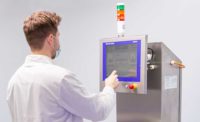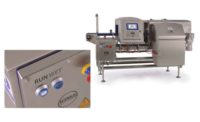Reducing Product Effect in Chilled and Frozen Foods During Metal Detection
Improvements in the accuracy of metal detection can pinpoint even the smallest fragments and elusive grades of stainless steel in foods.

Metal detection today remains the backbone of food safety compliance for the majority of the industry, but especially in the chilled and frozen food sector. Specifically, simultaneous multi-frequency scanning is making it much easier for manufacturers to identify hard-to-find metals in food products with high conductivity (so-called "wet" products). These products may, literally, have high water content. Additionally, above-average conductivity may also be linked to high levels of minerals, particularly salt. These can be found in products such as bacon, or ready meals.
For years, this type of product effect has posed a challenge for North American producers of meat, dairy, ready meals and baked goods, but also for some less obvious categories such as fortified (iron enriched) breakfast cereals and dietary supplements with high levels of added minerals.
The Product-Effect Challenge
The performance of food inspection machines deployed in refrigerated and frozen plants will be affected by product characteristics and density as they pass through the aperture.
There are two distinct components to metal detection: magnetic permeability and conductivity. Most food products will leave a ‘fingerprint’ that combines elements of both, though the overriding component is likely to be conductivity. Metals also exhibit telltale combinations of both types of effect. For example, the majority of ferrous metals display stronger magnetic permeability, while non-ferrous metals will signal higher conductivity. Indicators for stainless steel, on the other hand, can easily be swamped by product effect.
Manufacturers of ‘wet’ products have often had little choice but to tune their metal detection in a way that reduced margins of error and consequently tended to trigger excessive numbers of false positive rejects. It should come as no surprise that there is a hefty price tag attached to such levels of inaccuracy, both in terms of product losses and line stoppages. One industry estimate puts potential costs per production line at up to $18,500 per annum, depending on food type, cost, and line speeds.
Improvements to metal detection technology have dramatically reduced this type of problem. In practical terms, some of the newest systems are capable of pinpointing metal fragments with dimensions half those detectable with the previous generation of equipment, with the same degree of reliability.
Any reputable supplier of metal detection equipment understands that, while compliance with Hazard and Critical Control Point (HACCP) requirements for food safety is of the utmost importance, manufacturers increasingly have their own overall equipment effectiveness (OEE) targets too. If the metal detector on a given line cannot distinguish between the ‘product effect’ and metal contamination and this problem repeats itself, it can have a massive impact on line performance and wider OEE.
The tendency can be especially pronounced with grades of stainless steel typically used in processing and packaging line equipment, which tend to exhibit low magnetic permeability and low conductivity. This makes these grades of steel among the most difficult metals to detect, but even these tricky characteristics tend not to cause problems, or trigger false rejects, in dry foods. That is far more likely to happen in ‘wet’ products.
For all these reasons, the bar in metal detection has to be set where the combination of contaminant signature and product effect is most problematic. In other words, for manufacturers of ‘wet’ products, the ‘acid test’ for HACCP compliance in checking for potential contaminants has to be the detection of hard-to-find stainless steel in their hard-to-scan product matrices. The last few years have seen equipment manufacturers address this challenge – and clear this high bar.
Density Variations in Raw, Cooked and Frozen Foods
Product effect can be more pronounced with trying to detect contaminants in products where the density varies, for example frozen cuts of meat, whole fresh chickens, grated cheeses, frozen desserts or chilled ready meals. Additionally, the freezing, thawing and tempering of products can alter product composition. This again can cause an adverse reaction in the magnetic field, resulting in higher false rejects.
However, the sensitivity that can be gained from simultaneous frequency systems means that product effect can effectively be eliminated. The technology works by carrying out a real-time analysis of a low frequency and a high frequency signal in parallel. Using an advanced algorithm, product and metal detection signals are split and then linked back together.
Compared to the traditional approach of tuning into specific frequencies, this methodology makes it possible to identify the product effect - most noticeable at lower frequencies - and eliminate it from the higher-frequency signal, where the potential effect of the metal is more prominent.
Access to such granular detail, even at high line speeds, has been a game-changer for the food industry, and one which can be applied to metal detection not just of finished packs but also of free-flowing pumped liquid or powdered product. Other valuable benefits include the ability to more accurately inspect product packaged in metalized film.
Looking for a reprint of this article?
From high-res PDFs to custom plaques, order your copy today!






